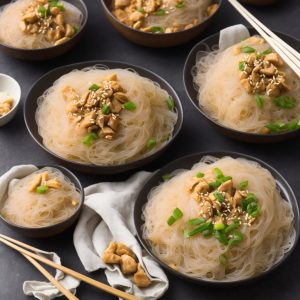Savor the natural sweetness and earthy flavors of kabocha and root vegetables in this comforting soup. This recipe blends the distinctive flavor of kabocha with a medley of root vegetables, resulting in a creamy, hearty soup that's perfect for a cold day.

Photos of Kabocha and Root Vegetable Soup Recipe
This recipe calls for kabocha squash, which may not be a staple in everyone's pantry. Kabocha is a Japanese pumpkin, known for its sweet flavor that's even richer than butternut squash. You can find it in most supermarkets, especially those that specialize in Asian foods. Another key ingredient is coriander seeds. These add a touch of warmth and a slight citrus undertone, enhancing the overall flavor of the soup.
Kabocha and Root Vegetable Soup Ingredients
Kabocha squash: A winter squash that offers a sweet, slightly nutty flavor. It blends well with other ingredients, making it a popular choice for soups.
Coriander seed: These seeds add a unique flavor profile to dishes, with tones of citrus, sweet, and warm.
Extra-virgin olive oil: Used for its rich flavor and health benefits.
Carrots: Adds a sweet and slightly earthy flavor to the soup.
Parsnip: A root vegetable that tastes similar to a carrot, but with a nuttier flavor.
Salt and ground black pepper: Enhances the natural flavors of the ingredients.
Leeks: Leeks contribute a gentle onion-like flavor that complements the taste of other vegetables.
Vegetable stock: Adds depth and rich flavor to the soup.
Basil: Its sweet, minty flavor adds a wonderful layer of flavor to the soup.
Water: Used to adjust the consistency of the soup.
Heavy whipping cream: Adds creaminess and richness to the soup.
One reader, Jacklin Salerno says:





This kabocha and root vegetable soup recipe is a game-changer! The combination of flavors is simply divine. The creamy texture and rich taste make it a comforting and satisfying meal. Plus, it's packed with healthy ingredients. I highly recommend trying it out!
Techniques Required for Making Kabocha and Root Vegetable Soup
How to prepare kabocha squash: Cut the kabocha squash into 1-inch chunks and carefully trim the peel off each chunk.
How to toast coriander seed: Heat a skillet over medium heat, add coriander seed, and toast in the skillet until the seeds start to turn golden brown and become fragrant for about 3 minutes. Then, grind the seeds in a coffee grinder.
How to sauté carrots and parsnip: Heat oil in a large stockpot over medium-high heat. Add carrots and parsnip; cook and stir until golden brown for 6 to 8 minutes. Season with salt and pepper.
How to puree the soup: Remove the soup from heat and puree with an immersion blender until smooth.
How to incorporate heavy cream: After pureeing the soup, stir in the heavy cream until well combined.
How To Make Kabocha and Root Vegetable Soup
A perfect pair for any dish, you’ll love this root vegetable soup that has the sweetness of the squash and the unique flavors of parsnips and carrots.
Serves:
Ingredients
- 2kabocha squash,halved and seeded
- 3tbspcoriander seed
- 1½tbspextra-virgin olive oil,or as needed
- 2carrots,diced
- 1parsnip,diced
- salt and ground black pepper,to taste
- 2leeks,dark green parts removed, sliced
- 8cupsvegetable stock
- 3tbspbasil,dried
- water,to cover
- 1cupheavy whipping cream
Instructions
-
Cut kabocha squash into 1-inch chunks and carefully trim the peel off each chunk.
-
Heat a skillet over medium heat. Add coriander seed. Toast in the skillet until seeds start to turn golden brown and become fragrant for about 3 minutes. Grind seeds in a coffee grinder.
-
Heat oil in a large stockpot over medium-high heat. Add carrots and parsnip; cook and stir until golden brown for 6 to 8 minutes. Season with salt and pepper.
-
Add leeks and ground coriander; saute until soft, adding a little stock if the pot gets dry. Add the kabocha, remaining vegetable stock, and basil.
-
Add water to cover the squash, if necessary. Bring soup to a boil; reduce to simmer. Continue simmering until squash is tender for 25 to 35 minutes.
-
Remove soup from heat. Puree with an immersion blender until smooth. Stir in heavy cream.
Nutrition
- Calories: 423.21kcal
- Fat: 28.53g
- Saturated Fat: 14.59g
- Monounsaturated Fat: 10.75g
- Polyunsaturated Fat: 1.69g
- Carbohydrates: 43.74g
- Fiber: 8.96g
- Sugar: 6.70g
- Protein: 5.22g
- Cholesterol: 81.52mg
- Sodium: 1978.04mg
- Calcium: 218.32mg
- Potassium: 1204.70mg
- Iron: 3.82mg
- Vitamin A: 596.64µg
- Vitamin C: 39.26mg
Essential Technique Tips for Perfecting This Soup Recipe
When pureeing the soup with an immersion blender, make sure to blend it in batches if your pot is too full. Overfilling can cause the soup to splatter and create a mess. Also, allow the soup to cool slightly before blending to avoid steam build-up which can cause the blender lid to pop off. Remember, achieving a smooth, creamy texture is key for this kabocha and root vegetable soup.
Time-Saving Tips for Preparing This Soup Recipe
Prep ahead: Chop and prepare all the vegetables and spices in advance to streamline the cooking process.
Use a food processor: Utilize a food processor to quickly and efficiently chop the vegetables, saving time and effort.
Simmer efficiently: Increase the heat to bring the soup to a boil, then reduce to a simmer to speed up the cooking process.
Multi-task: While the soup is simmering, use that time to clean and tidy up the kitchen to save time later.
Organize ingredients: Arrange all the ingredients and utensils in an organized manner before starting to cook for a smoother process.
Quick blending: Use an immersion blender for quick and easy pureeing directly in the pot, eliminating the need to transfer the soup to a blender.
Substitute Ingredients For Kabocha and Root Vegetable Soup Recipe
kabocha squash - Substitute with butternut squash: Butternut squash has a similar sweet and nutty flavor to kabocha and can be used as a substitute in this recipe.
coriander seed - Substitute with cumin seeds: Cumin seeds have a warm and earthy flavor similar to coriander seeds, making it a suitable substitute in this soup recipe.
extra-virgin olive oil - Substitute with avocado oil: Avocado oil has a mild flavor and high smoke point, making it a good substitute for olive oil in this recipe.
carrots - Substitute with sweet potatoes: Sweet potatoes can add a similar sweetness and texture to the soup as carrots.
parsnip - Substitute with turnip: Turnips have a slightly peppery and sweet flavor similar to parsnips and can be used as a substitute in this recipe.
leeks - Substitute with yellow onions: Yellow onions can provide a similar mild and sweet flavor to the soup as leeks.
vegetable stock - Substitute with chicken stock: Chicken stock can add a rich and savory flavor to the soup, similar to vegetable stock.
basil - Substitute with thyme: Thyme can add a earthy and slightly minty flavor to the soup, similar to basil.
heavy whipping cream - Substitute with coconut cream: Coconut cream can add a creamy and rich texture to the soup, similar to heavy whipping cream.
Best Way to Present Kabocha and Root Vegetable Soup
Elevate the plating: When presenting the kabocha and root vegetable soup, focus on creating a visually appealing presentation. Use a wide-rimmed bowl to showcase the vibrant colors and textures of the soup. Ensure that the soup is evenly distributed in the bowl, and use a garnish of freshly chopped herbs, such as chives or parsley, to add a pop of color and freshness.
Incorporate texture: Consider adding a crunchy element to the dish to provide contrast to the smoothness of the soup. A sprinkle of toasted pumpkin seeds or a small cluster of crispy kale chips on top of the soup can add an interesting textural component to the dish.
Artful drizzling: Before serving, drizzle a small amount of high-quality extra-virgin olive oil in a circular motion on the surface of the soup. This not only adds a touch of richness but also creates an elegant visual effect that enhances the overall presentation.
Use complementary serveware: Select elegant, high-quality serveware that complements the sophistication of the dish. Consider serving the soup in a beautiful, artisan-crafted bowl that adds a touch of refinement to the overall presentation.
Attention to detail: Pay close attention to the final presentation, ensuring that the rim of the bowl is clean and free of any drips or spills. A meticulous approach to plating demonstrates a commitment to excellence and attention to detail.
Essential Tools for Making This Delicious Soup
- Cutting board: A flat surface used for cutting and preparing ingredients.
- Chef's knife: A versatile knife used for chopping, slicing, and dicing ingredients.
- Skillet: A frying pan with a flat bottom and sloping sides used for sautéing and frying.
- Coffee grinder: Used to grind spices and seeds to a fine powder.
- Stockpot: A large pot used for making soups, stocks, and stews.
- Immersion blender: A handheld blender used for pureeing soups and sauces directly in the pot.
Storing and Freezing Kabocha and Root Vegetable Soup
Let the kabocha and root vegetable soup cool completely before storing or freezing. This will prevent condensation from forming and diluting the flavors.
For short-term storage, transfer the cooled soup to an airtight container and refrigerate for up to 5 days. The flavors will continue to develop and meld together over time.
If you plan to freeze the soup, consider portioning it into individual serving sizes for easy reheating later. Pour the cooled soup into freezer-safe containers or resealable bags, leaving about an inch of headspace to allow for expansion during freezing.
Label the containers or bags with the date and contents, so you can easily keep track of your frozen soup inventory.
When freezing, lay the bags flat in the freezer to maximize storage space. Once frozen solid, you can stack them vertically to save room.
Kabocha and root vegetable soup can be frozen for up to 3 months without significant loss of quality. However, the texture of the vegetables may become slightly softer after thawing.
To reheat frozen soup, transfer it to the refrigerator to thaw overnight. Alternatively, you can thaw it in the microwave using the defrost setting.
Once thawed, pour the soup into a pot and reheat it gently over medium-low heat, stirring occasionally to prevent scorching. Adjust the seasoning if needed and add a splash of cream or stock to restore the desired consistency.
If you find that the vegetables have become too soft after freezing and reheating, you can puree the soup again with an immersion blender to create a smooth and creamy texture.
How To Reheat Leftover Kabocha and Root Vegetable Soup
To reheat leftover kabocha and root vegetable soup, start by transferring the desired portion into a microwave-safe bowl. Cover the bowl with a damp paper towel or a microwave-safe lid, leaving a small gap for steam to escape. Microwave on high for 1-2 minutes, stirring halfway through, until the soup is heated through and steaming.
For a stovetop method, pour the leftover soup into a saucepan and heat it over medium-low heat. Stir occasionally to prevent the soup from sticking to the bottom of the pan. Heat the soup until it reaches your desired temperature, which should take about 5-7 minutes.
If you find that the reheated soup has thickened too much, you can thin it out by adding a splash of vegetable stock or water. Stir well to incorporate the added liquid and adjust the seasoning with salt and pepper if needed.
To add a fresh twist to your reheated soup, consider garnishing it with a dollop of sour cream, a sprinkle of chopped fresh herbs like parsley or cilantro, or a handful of crispy croutons.
If you have a large portion of leftover soup, you can reheat it in the oven. Preheat the oven to 350°F (175°C), transfer the soup to an oven-safe dish, cover it with foil, and heat for 15-20 minutes, or until the soup is warmed through. Stir the soup halfway through the reheating process to ensure even heating.
Interesting Facts About Kabocha and Root Vegetables
The kabocha and root vegetable soup recipe is a great source of vitamins and minerals. Kabocha squash is packed with beta-carotene, which is beneficial for eye health and immune function. Additionally, root vegetables like carrots and parsnips are high in fiber and antioxidants, promoting good digestion and overall well-being. This soup is not only delicious but also nutritious, making it a perfect addition to a healthy diet.
Is Making Kabocha and Root Vegetable Soup Cost-Effective?
This kabocha and root vegetable soup recipe is highly cost-effective for a household. The main ingredients, such as kabocha squash, carrots, and parsnips, are affordable and readily available. The use of seasonal vegetables and basic pantry staples makes it a budget-friendly option. The estimated cost for a household of 4 people is approximately $15. The soup is nutritious, delicious, and versatile, making it a great addition to any meal plan. Overall Verdict: 9/10
Is This Soup Recipe Healthy or Unhealthy?
The kabocha and root vegetable soup recipe is a relatively healthy dish, offering several nutritional benefits:
- Kabocha squash is rich in vitamins A and C, which support immune function and skin health.
- Carrots and parsnips provide additional vitamins, minerals, and dietary fiber.
- Leeks offer vitamins A, C, and K, as well as beneficial antioxidants.
- Vegetable stock keeps the soup low in calories and fat compared to cream-based soups.
However, there are a few aspects that could be improved:
- The recipe calls for a cup of heavy cream, which adds significant amounts of saturated fat and calories. While this enhances the soup's richness and creaminess, it may not be the healthiest choice.
- The salt content is not specified, making it difficult to gauge the soup's sodium levels.
To make this soup even healthier, consider the following suggestions:
- Replace the heavy cream with a lower-fat alternative, such as half-and-half, light coconut milk, or Greek yogurt. This will reduce the saturated fat content while maintaining a creamy texture.
- Use low-sodium vegetable stock to control the soup's salt content. You can always adjust the seasoning to taste with a pinch of salt at the end.
- Increase the variety of vegetables in the soup. Consider adding celery, turnips, or sweet potatoes for extra nutrients and flavor complexity.
- Garnish the soup with fresh herbs like parsley or cilantro, which add brightness and a pop of color.
- Serve the soup with a side salad or whole-grain bread to make it a more balanced and filling meal.
Editor's Thoughts on This Delightful Kabocha Soup
The kabocha and root vegetable soup recipe is a delightful blend of flavors and textures. The combination of kabocha squash, carrots, parsnip, and leeks creates a rich and hearty base, while the toasted coriander seed adds a warm and aromatic essence. The addition of basil infuses a fresh herbal note, complementing the earthy sweetness of the vegetables. The finishing touch of heavy cream lends a luxurious creaminess to the soup, elevating it to a truly indulgent dish. Overall, this recipe offers a harmonious balance of ingredients and is sure to delight the palate with its comforting and satisfying qualities.
Enhance Your Kabocha and Root Vegetable Soup Recipe with These Unique Side Dishes:
Delicious Alternatives to Kabocha and Root Vegetable Soup
Appetizers and Desserts to Complement Kabocha Soup
Why trust this Kabocha and Root Vegetable Soup Recipe:
This recipe uses kabocha squash and root vegetables that are packed with essential nutrients and flavors. The combination of coriander seed and basil adds a unique and aromatic touch to the soup. The use of extra-virgin olive oil and heavy whipping cream enhances the richness and creaminess of the dish. The step-by-step instructions ensure that the soup is prepared with care and attention to detail. Trust in the quality and balance of ingredients, as well as the expertise behind this recipe.
Was this page helpful?
Have your own special recipe to share? Submit Your Recipe Today!











